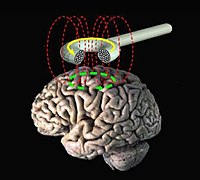
Photo from wikipedia
Combined single-pulse transcranial magnetic stimulation (TMS) and electroencephalography (EEG) has been used to probe the features of local networks in the cerebral cortex. Here we investigate whether we can use… Click to show full abstract
Combined single-pulse transcranial magnetic stimulation (TMS) and electroencephalography (EEG) has been used to probe the features of local networks in the cerebral cortex. Here we investigate whether we can use this approach to explore long-range connections between the cerebellum and cerebral cortex. Ten healthy adults received single-pulse suprathreshold TMS to the cerebellum and an occipital/parietal control site with double-cone and figure-of-eight coils while cerebral activity was recorded. A multisensory electrical control condition was used to simulate the sensation of the double-cone coil at the cerebellar site. Two cleaning pipelines were compared, and the spatiotemporal relationships of the EEG output between conditions were examined at sensor and source levels. Cerebellar stimulation with the double-cone coil resulted in large artefacts in the EEG trace. The addition of SOUND filtering to the cleaning pipeline improved the signal such that further analyses could be undertaken. The cortical potentials evoked by the active TMS conditions showed strong relationships with the responses to the multisensory control condition after ~50 ms. A distinct parietal component at ~42 ms was found following cerebellar double-cone stimulation. While evoked potentials differed across all conditions at early latencies, it is unclear as to whether these represented TMS-related network activation of the cerebellarthalamocortical tract, or whether components were dominated by sensory contamination and/or coil-driven artefacts. This study highlights the need for caution when interpreting outcomes from cerebellar TMS-EEG studies.
Journal Title: Journal of neurophysiology
Year Published: 2021
Link to full text (if available)
Share on Social Media: Sign Up to like & get
recommendations!